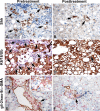Treatment response in the PIVENS trial is associated with decreased Hedgehog pathway activity
- PMID: 24849310
- PMCID: PMC4241186
- DOI: 10.1002/hep.27235
Treatment response in the PIVENS trial is associated with decreased Hedgehog pathway activity
Abstract
Hedgehog (Hh) ligand production by ballooned hepatocytes drives nonalcoholic steatohepatitis (NASH) progression in mice. The NIDDK-sponsored PIVENS trial (NCT00063622) showed that vitamin E (VitE) improved NASH. We investigated whether VitE treatment and improvement in NASH were associated with changes in Hh pathway activity. Immunohistochemistry (IHC) was performed on both pre- and posttreatment liver biopsies of 59 PIVENS patients randomized to VitE (n = 30) or placebo (n = 29). Sonic Hh (Shh) ligand-producing cells and Shh-responsive cells were quantified. The latter was accomplished by triple IHC for gli2+ (marker of Hh signaling), sox-9 (progenitor marker), and α-smooth muscle actin (α-SMA; myofibroblast marker). Ballooned hepatocytes were quantified by keratin 8/18 and ubiquitin (K8/18/Ub) staining. IHC results were correlated with primary clinical and histologic PIVENS data. Pretreatment clinical, histologic, and IHC parameters did not differ significantly in the two treatment groups. Regardless of treatment arm, the number of Shh+ hepatocytes correlated with K8/18/Ub foci (r(2) = 0.47, P < 0.001) and aspartate aminotransferase (AST) (r(2) = 0.15, P = 0.002). Treatment-related changes in the numbers of Shh+ hepatocytes correlated with changes in serum AST (partial r(2) = 0.75, P < 0.0001), hepatocyte ballooning (P = 0.004), the ductular reaction (i.e., numbers of gli2+/sox9+ cells; P = 0.03 and α-SMA+ cells; P = 0.10), and fibrosis stage (P = 0.02). Treatment response was associated with a greater decrease in Shh+ hepatocytes than nonresponse (P = 0.007). The VitE group demonstrated a greater reduction in K8/18/Ub+ foci (P < 0.08) and Shh+ hepatocytes (P < 0.05) than the placebo group, effects that became more significant after correction for baseline differences and multiple linear regression analysis.
Conclusion: During PIVENS, treatment response correlated with loss of Shh+ hepatocytes and improvement in Hh-regulated processes that promote NASH progression.
© 2014 by the American Association for the Study of Liver Diseases.
Figures




Comment in
-
Ballooned hepatocytes, undead cells, sonic hedgehog, and vitamin E: therapeutic implications for nonalcoholic steatohepatitis.Hepatology. 2015 Jan;61(1):15-7. doi: 10.1002/hep.27279. Epub 2014 Nov 20. Hepatology. 2015. PMID: 24975580 Free PMC article. No abstract available.
-
Reply: To PMID 24849310.Hepatology. 2015 May;61(5):1770-1. doi: 10.1002/hep.27430. Epub 2015 Mar 20. Hepatology. 2015. PMID: 25209009 Free PMC article. No abstract available.
-
GLI2 as a marker of hedgehog-responsive cells.Hepatology. 2015 May;61(5):1770. doi: 10.1002/hep.27432. Epub 2015 Mar 19. Hepatology. 2015. PMID: 25209117 No abstract available.
-
The fat droplet in hepatocellular ballooning and implications for scoring nonalcoholic steatohepatitis therapeutic response.Hepatology. 2016 Mar;63(3):1056-7. doi: 10.1002/hep.28009. Epub 2015 Oct 1. Hepatology. 2016. PMID: 26206460 No abstract available.
-
Reply.Hepatology. 2016 Mar;63(3):1057-8. doi: 10.1002/hep.28011. Epub 2015 Oct 6. Hepatology. 2016. PMID: 26206676 No abstract available.
References
-
- Loomba R, Sanyal AJ. The global NAFLD epidemic. Nat Rev Gastroenterol Hepatol. 2013;10(11):686–690. - PubMed
-
- Roberts EA. Pediatric nonalcoholic fatty liver disease (NAFLD): a “growing” problem? J Hepatol. 2007;46(6):1133–1142. - PubMed
-
- Sanyal AJ, Chalasani N, Kowdley KV, McCullough A, Diehl AM, Bass NM, Neuschwander-Tetri BA, Lavine JE, Tonascia J, Unalp A, Van Natta M, Clark J, Brunt EM, Kleiner DE, Hoofnagle JH, Robuck PR. NASH CRN. Pioglitazone, vitamin E, or placebo for nonalcoholic steatohepatitis. N Engl J Med. 2010;362(18):1675–85. - PMC - PubMed
-
- Matteoni CA, Younossi ZM, Gramlich T, Boparai N, Liu YC, McCullough AJ. Nonalcoholic fatty liver disease: a spectrum of clinical and pathological severity. Gastroenterology. 1999;116(6):1413–9. - PubMed
Publication types
MeSH terms
Substances
Associated data
Grants and funding
- U01DK061713/DK/NIDDK NIH HHS/United States
- U01 DK061732/DK/NIDDK NIH HHS/United States
- R37 AA010154/AA/NIAAA NIH HHS/United States
- R01-DK077794/DK/NIDDK NIH HHS/United States
- RC2 AA019399/AA/NIAAA NIH HHS/United States
- U01 DK061730/DK/NIDDK NIH HHS/United States
- 5RC2 AA019399/AA/NIAAA NIH HHS/United States
- U01 DK061737/DK/NIDDK NIH HHS/United States
- U01 DK061713/DK/NIDDK NIH HHS/United States
- R01 DK053792/DK/NIDDK NIH HHS/United States
- R01-DK053792/DK/NIDDK NIH HHS/United States
- U01 DK061738/DK/NIDDK NIH HHS/United States
- R01 DK077794/DK/NIDDK NIH HHS/United States
LinkOut - more resources
Full Text Sources
Other Literature Sources
Medical
Research Materials
Miscellaneous
